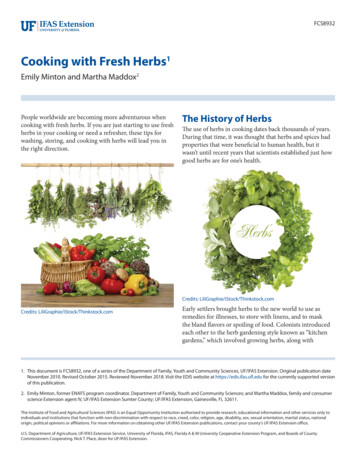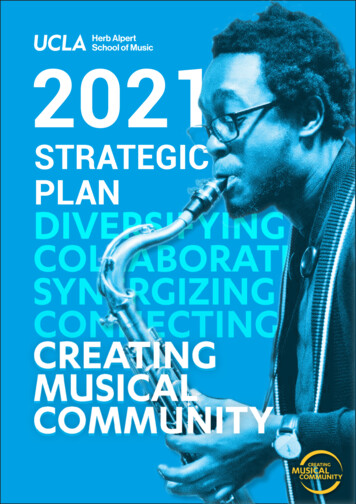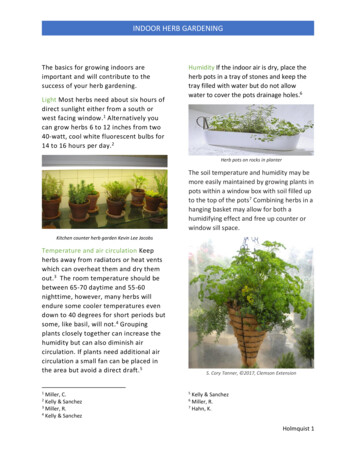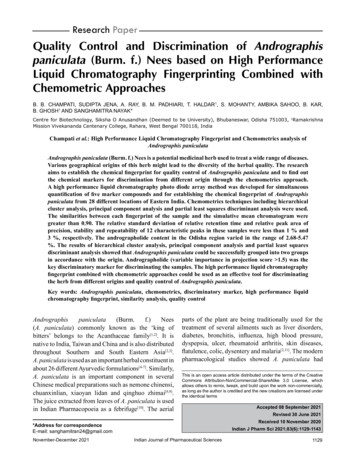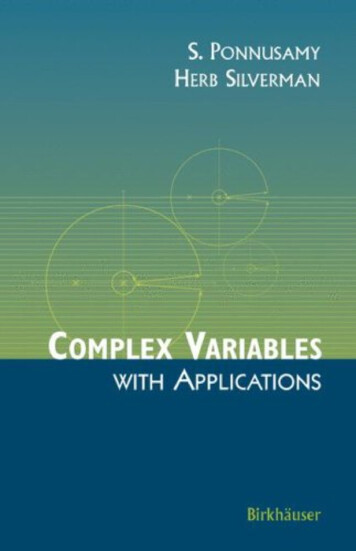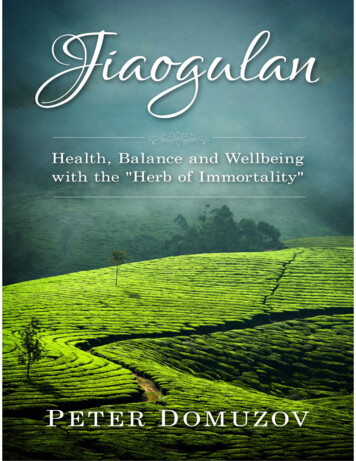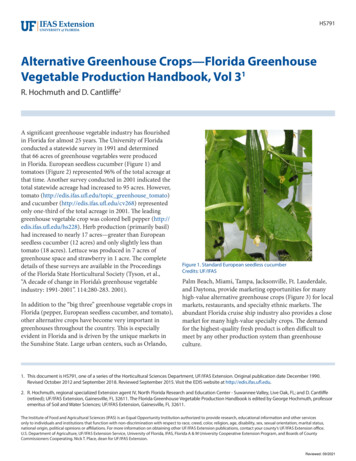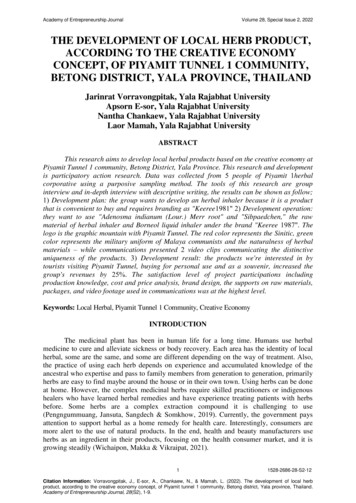
Transcription
Academy of Entrepreneurship JournalVolume 28, Special Issue 2, 2022THE DEVELOPMENT OF LOCAL HERB PRODUCT,ACCORDING TO THE CREATIVE ECONOMYCONCEPT, OF PIYAMIT TUNNEL 1 COMMUNITY,BETONG DISTRICT, YALA PROVINCE, THAILANDJarinrat Vorravongpitak, Yala Rajabhat UniversityApsorn E-sor, Yala Rajabhat UniversityNantha Chankaew, Yala Rajabhat UniversityLaor Mamah, Yala Rajabhat UniversityABSTRACTThis research aims to develop local herbal products based on the creative economy atPiyamit Tunnel 1 community, Betong District, Yala Province. This research and developmentis participatory action research. Data was collected from 5 people of Piyamit 1herbalcorporative using a purposive sampling method. The tools of this research are groupinterview and in-depth interview with descriptive writing, the results can be shown as follow;1) Development plan: the group wants to develop an herbal inhaler because it is a productthat is convenient to buy and requires branding as "Keeree1981" 2) Development operation:they want to use "Adenosma indianum (Lour.) Merr root" and "Sibpaedchen," the rawmaterial of herbal inhaler and Borneol liquid inhaler under the brand "Keeree 1987". Thelogo is the graphic mountain with Piyamit Tunnel. The red color represents the Sinitic, greencolor represents the military uniform of Malaya communists and the naturalness of herbalmaterials – while communications presented 2 video clips communicating the distinctiveuniqueness of the products. 3) Development result: the products we're interested in bytourists visiting Piyamit Tunnel, buying for personal use and as a souvenir, increased thegroup's revenues by 25%. The satisfaction level of project participations includingproduction knowledge, cost and price analysis, brand design, the supports on raw materials,packages, and video footage used in communications was at the highest level.Keywords: Local Herbal, Piyamit Tunnel 1 Community, Creative EconomyINTRODUCTIONThe medicinal plant has been in human life for a long time. Humans use herbalmedicine to cure and alleviate sickness or body recovery. Each area has the identity of localherbal, some are the same, and some are different depending on the way of treatment. Also,the practice of using each herb depends on experience and accumulated knowledge of theancestral who expertise and pass to family members from generation to generation, primarilyherbs are easy to find maybe around the house or in their own town. Using herbs can be doneat home. However, the complex medicinal herbs require skilled practitioners or indigenoushealers who have learned herbal remedies and have experience treating patients with herbsbefore. Some herbs are a complex extraction compound it is challenging to use(Pengngummuang, Jansuta, Sangdech & Somkhow, 2019). Currently, the government paysattention to support herbal as a home remedy for health care. Interestingly, consumers aremore alert to the use of natural products. In the end, health and beauty manufacturers useherbs as an ingredient in their products, focusing on the health consumer market, and it isgrowing steadily (Wichaipon, Makka & Vikraipat, 2021).11528-2686-28-S2-12Citation Information: Vorravongpitak, J., E-sor, A., Chankaew, N., & Mamah, L. (2022). The development of local herbproduct, according to the creative economy concept, of Piyamit tunnel 1 community, Betong district, Yala province, Thailand.Academy of Entrepreneurship Journal, 28(S2), 1-9.
Academy of Entrepreneurship JournalVolume 28, Special Issue 2, 2022Betong District, Yala province, is located in the southernmost of Thailand, surroundedby the mountains located in Malaysia. Therefore the weather is almost cool all year round. Inthe past, Betong District had a Malaya Communist party, a Chinese-Malay who took up armsto fight political and settle political army base here. This place became a tourist attractionknown as the "Piyamit Tunnel" when the political situation unraveled the communists downtheir weapons to rely on the Bodhisombara and change the status to "Thai Nationdevelopment cooperators" established the Piyamit village. For this circumstance, the Thaigovernment has come to help develop infrastructure and careers and saw the potential ofpromoting tourism in Betong District. The budget was approved to build an internationalairport in Betong District and raise Betong as a project model. "The Triangle of Stability,Prosperity, and Sustainability (Kaewngam & Jongwilaikasaem, 2019). Betong District is alsothe third-highest cross-border trade city in the South after the Sadao Customs House andPadang Besar, respectively (Department of Foreign Trade, 2021).The local herbal business of Tunnel Piyamit 1was initiated during the period ofestablishment of Thai Nation development cooperators staying hidden as communists ofMalaya. For them, it was inconvenient to do activities outside. Therefore, they had to learnmore various skills, especially medical skills. That was why the communists of Malaya senttheir members to learn about medical skills and local herbal from China. The traditionalChinese doctors applied the treatment with local wild herbal. After the communist group waschanged to a group of Thai Nation development cooperators, the wild herbal knowledgepassed to the next generation and their grandchild for remedy. Then the government paidattention to promote tourism development. The successors produced 3 products as the firstperiod: Lingzhi mushroom, healing high blood pressure, diabetes, high blood lipids, wildpepper root, treating gout, dyspepsia, cancer prevention, and Da Si Wang, treating liverdisease, jaundice, nourishing the brain, increasing vitality. The identity products of Piyamit 1are wild stink bean roots with properties of kidneys detoxify, lower blood sugar. Also, WuZhao Ma Tee (5-clawed dragon) treats kidney disease strengthens the kidneys diuretic. Afterthe mentioned products succeeded, many more products were developed. Initially, thepackaging was just a clear plastic bag with a sticker later, the Betong CommunityDevelopment Office came to help build the packaging. The beautiful screen packaging lookstrustworthy for distribution. It has been registered as an OTOP product and received acommunity product standard mark (CMU) under the brand "Piyamit Tunnel 1, currentlylocated at Baan Piyamit 1, Tanomaro Subdistrict, Yala Province.The benefit of the health of Piyamit Tunnel herbal 1 is prevention and remedy, this isconsistent with health tourism (Praprom & Laipaporn, 2021), but the process of using herbalis quite cumbersome and inconvenient for modern lifestyles. Therefore, it's bought mainly byelderly Chinese customers who take care of their health and obsesses with herbal tea. Thesale target is stable. Thus, the group wants to develop new potential products to increaserevenue for the group. Therefore, this is the first step of the local herbal development basedon the creative economy of the Piyamit Tunnel community. This is to drive and develop theeconomy with creativity, added value for products and services (Oontornpan & Polpak, 2018)based on local wisdom, daily living, culture, raw materials, area characteristics, etc. todevelop contemporary products and unique and able to add value for the Piyamit Tunnelcommunity, Betong District, Yala Province with stability, prosperity and sustainability.ObjectiveTo develop an herbal product of Piyamit Tunnel 1 community, Betong District, YalaProvince, based on creative economic guidelines.21528-2686-28-S2-12Citation Information: Vorravongpitak, J., E-sor, A., Chankaew, N., & Mamah, L. (2022). The development of local herbproduct, according to the creative economy concept, of Piyamit tunnel 1 community, Betong district, Yala province, Thailand.Academy of Entrepreneurship Journal, 28(S2), 1-9.
Academy of Entrepreneurship JournalVolume 28, Special Issue 2, 2022LITERATURE REVIEWA creative economy is based on people's creative imagination to create somethingnew, different from the existing one (Wijaya, Rahyuda, Yasa & Sukaatmadja, 2019). Theproducts of innovative economy concepts are also crucial in supporting tourism (Budhia,Lestarib, Suasiha & Wijaya, 2020). Additionally, the creative economy help to develop theeconomy and enhance the competition ability at the international level, regional level, andlocal level (Munro, 2017; Boccella & Salerno, 2016). The Organization for Cooperation forTrade and Development or UNCTAD (2008) has said that the creative economy grows anddrives economic development based on innovative ideas. It can create jobs opportunities andgenerate income, while Patluang, (2011) discussed the initiated creative economy process,divided jobs into two sub-parts as follows:1. Process of creating knowledge, creative idea, and technology consist of essentialknowledge and technology. The basic knowledge comes from ancient wisdom and newknowledge, but it describes the as wide range. Therefore, to directly practice the basicknowledge has to change into old technology and new technology. It determines the methodand production process2. The process of commercializing creativity and technology, which includesinnovation. Before offering to customers, this could be a new product or service, uniqueproduction process, new raw material, organization, etc.While E-sor, Sunsan, Keatnaremon, Promsriya & Jeharrong (2018) mentioned thateconomic development follows the guideline of creative economic that divided into 3 steps 1)development planning, is the study of wisdom, expertise, and business identity. This could bethe knowledge, daily living style, culture, raw materials, local characteristics, etc., that standout from competitors. It can determine the direction of development; 2) the implementationof the development action. It is a product development as per the specified plan. The thingsthat develop would be product pattern, brand, packaging, target market, price, marketingpromotion, etc. 3) Summary of development results: The product presentation to the customerand studying the success of the organization's goals such as sales and profits, etc.Chollatep (2013) conducted research about the guideline of how to apply the creativeeconomic concept. It was found that creating a creative economy requires academicknowledge, creative work, and the use of intellectual property to be a primary factor and alsousing the accumulation of knowledge, technology, and innovation to create products withvalue-added. The standard quality of resources should be valuable, rare, irreplaceable, andinimitable. When combined together, the ability in competition is more enhancing. Creativityleads the product with more value and sustainable business. This is consistent with theInstitute of Small and Medium Enterprise Development (2012) context about the creativeeconomy. They mentioned the word "identity," which refers to the unique characteristics ofproducts and services, different from other products or services such as raw materials,products, brands logo, packaging, communication, marketing promotions, etc.RESEARCH METHODOLOGYThis research and the development collected data by group interview, developmentoperation, and in-depth interview. This research was divided in three phrases which weredevelopment plan, implementation development, and result summary of creative economicdevelopment as the following:1. The development plan based on creative economics. It was conducted by a groupinterview with people operating in Piyamit 1 herb corporative. They were the chairman, vicepresident, marketing, production department, and financial department, total of five people.This interview aims to study the direction of local herbal development products in line with31528-2686-28-S2-12Citation Information: Vorravongpitak, J., E-sor, A., Chankaew, N., & Mamah, L. (2022). The development of local herbproduct, according to the creative economy concept, of Piyamit tunnel 1 community, Betong district, Yala province, Thailand.Academy of Entrepreneurship Journal, 28(S2), 1-9.
Academy of Entrepreneurship JournalVolume 28, Special Issue 2, 2022creative economic, which consists of demand of local herb development products, localherbal product identity, target market, and brand.2. The development operation in economics was about detail and the factual ofproducts in line with creative economics. However, the development operation focuses onoutcomes, branding and logo, and communication.3. The development result based on a creative economic was derived from in-depthinterview with the manager of a group of Piyamit 1 Herbal corporative. This is to study theoccurring result as commercial part and how satisfaction of participants joining the project.In terms of developing and testing reliability data, the researcher had studieddocuments, textbooks, and research about the creative economy to designed research tools;thus, the three marketing and business experts were selected to criticize the conformity andresearch objectives, the suitability, and ability to communicate. There was a trail with a groupidentical to the target group study of five people. The result from the trail was used toimprove the tool for more effectiveness. The information was analyzed, synthesized,compared, and written a rational description using data triangulation of Denizen method interms of data collection, target groups, and period.RESULTSThe results can be classified into three parts as per research design, development plan,operation development, and development result based on creative economic developmentfound that;The development plan based on creative economic, from group interview of operationperson in Piyamit 1 Herb corporative which were chairman, vice president, marketingdepartment, production department, and financial department, to study the direction of localherbal development products in line with creative economic found that;The requirements of the local herbal product development and product identity,including target marketFrom the interview with the persons who operate the Piyamit 1 Herb Cooperative,they were required to develop 3 herbal products: 1) Essence Chicken Soup. This is becausethere is a medicinal plant, namely "Dali Wang," in the group. It is the primary raw materialfor making the extracted chicken soup. The properties of Dali Wang are to help nourish,increase energy, reduce blood lipid. Therefore, the target market is the manpower who wantsto boost their energy. 2) Herbal inhaler because it is a convenience product, easy to buy andsell. It's made from local herbs "Adenosma Indiana (Lour,) Merr. root" and "Sibpaedchen"are the primary raw materials, their properties able to increase blood circulation and breathemore fluently. The market target is the people who need soothing inhalation products forrelief of dizziness and refreshing. 3) Herbal for a foot bath focuses on exhausted tourists fromwalking around the Piyamit Tunnels. It's made from wild pepper roots and Sibpaedchen, theprimary raw material for production properties to help relieve pain, swelling, and sprains.After brainstorming and voting, the group chose to produce herbal inhalers at 80%.Branding and logo designThe group suggested three options to name brand 1)"Piyamit Tunnel 1" because it isconsistent with exiting herbal product 2) "Keeree1987" because it is the year of membercame down from the mountain to join with government and changed status to "Thai nationdevelopment cooperators" 3) " Keeree 428" because this is the month and date (April, 28th)of joining government and changed status to " Thai Nation development cooperators. It canbe noticed that the elder group selected option 1 because they are traditional, don't like to41528-2686-28-S2-12Citation Information: Vorravongpitak, J., E-sor, A., Chankaew, N., & Mamah, L. (2022). The development of local herbproduct, according to the creative economy concept, of Piyamit tunnel 1 community, Betong district, Yala province, Thailand.Academy of Entrepreneurship Journal, 28(S2), 1-9.
Academy of Entrepreneurship JournalVolume 28, Special Issue 2, 2022change. Still, the young generation wants to change to option 2 or 3 because the old brand isoutdated and duplicated with the other Tunnel Piyamit group. However, the poll shows thatthe brand "Keeree (1987)" is highly voted at 60%.The development operation in economic, the researcher operated in productdevelopment according to the mapping plan. However, the development operation focuses onproducts, branding and logo, and communication.ProductsThe researchers developed an herbal inhaler for the community of Piyamit Tunnel 1,by inviting a speaker to cooperate in testing local herbal "Adenosma Indiana (Lour.) Merr.Root and "Sibpaedchen" mixed together with the main material of inhaler products until theformula is on set, all the raw material, and packaging distributed to the group. However, sinceherbal inhalers have the same basic ingredient formulas as borneol liquid products, theresearcher team has supported more raw materials and packaging for making "borneolliquid." Support the production of 100 pieces of borneol liquid and 100 more herbal inhalers,set training course of borneol liquid production and herbal inhalers. This training course wasorganized on February 20th, 2021, at Piyamit Tunnel 1 Community Office, TanomaroSubdistrict, Betong District, Yala Province.Branding and logo designReferring to the meaning of "Keeree1987," which was the year members came to jointhe government and change status to "Thai Nation Cooperators" began the group of PiyamitTunnel. From this concept, the logo was designed as Graphic Mountain with Piyamit Tunnelcity gate, used red and green color. Red color represents Sinitic people, and green colorrepresents military (Communist Malaya) and can be implied to natural herbal material.However, the researchers' team designed 3 logos for a group of Piyamit Tunnel 1 considerate,criticize, select and suggestion and brought all information to improve the logo again, addeddetails of ingredients, properties, establishment and distribution, and telephone number.Printed label for borneol liquid and herbal inhaler 100 pieces of each for the group. Please seethe product logo label and packaging as picture 1 and picture 2FIGURE 1LOGO OF BRAND "KEEREE (1987)"51528-2686-28-S2-12Citation Information: Vorravongpitak, J., E-sor, A., Chankaew, N., & Mamah, L. (2022). The development of local herbproduct, according to the creative economy concept, of Piyamit tunnel 1 community, Betong district, Yala province, Thailand.Academy of Entrepreneurship Journal, 28(S2), 1-9.
Academy of Entrepreneurship JournalVolume 28, Special Issue 2, 2022FIGURE 2LABEL AND PACKAGING OF BORNEOL LIQUID AND HERBAL INHALERCommunicationThere are 2 video clips created to present what product identity and made perceptionto customers and motivate them to buy. This is also a media of learning resource for thegroup of Piyamit Tunnel community. 1) The first video clip of borneol liquid and herbalinhaler "Keeree 1987" (water source & midstream). It is about ingredients and properties ofmaterials in borneol liquid and herbal inhaler production: menthol, borneol, camphor, blackpepper, clove flower, nutmeg, star anise, cinnamon, and dried peel of bergamot. Eucalyptusoil including local ingredients, which are "Adenosma Indiana (Lour.) Merr. root" and"Sibpeadchen" in package 2). The second video clip, borneol liquid and herbal inhaler "Keeree 1987" (downstream) focused on promotion and motivation of using productspresented by a model in working age with ambition. Hard-working and rush time are thecauses of exhaustion, and they want to relieve stress by using the products. For the mentionedreasons, the borneol liquid and herbal inhaler are positioning as the healer of sickness.The development result based on creative economics. The in-depth interview with themanager of Piyamit 1 Herbal corporative (Sachen, Interview, March 14, 2021) aboutdistributing borneol liquid and herbal inhaler "Keeree (1987)" at a corporative shop, theproducts attracted customers who visited Piyamit Tunnel. They appreciated the properties andscent of herbal products. They were relaxing after inhaling and relieved from tired and itchywith acceptable price, herbal inhaler 39 Baht, borneol liquid 59 Baht. However, they can buythe product as souvenirs for family and friends. The 200 pieces sold out shortly that makerscan increase the group's revenue to 25%. However, the group intends to produce more, butthe situation of COVID-19 causing fewer tourists to visit. The production has to be put off fora while. The satisfaction from participating in the project is the highest level. They appreciateproduction knowledge, price analysis, and brand design, including the support of rawmaterials, packaging, and video clips used in communication.61528-2686-28-S2-12Citation Information: Vorravongpitak, J., E-sor, A., Chankaew, N., & Mamah, L. (2022). The development of local herbproduct, according to the creative economy concept, of Piyamit tunnel 1 community, Betong district, Yala province, Thailand.Academy of Entrepreneurship Journal, 28(S2), 1-9.
Academy of Entrepreneurship JournalVolume 28, Special Issue 2, 2022DISCUSSIONThe discussion can be classified according to the research design.1. Focusing on the development plan based on creative economics, the research resultfound that the group of Piyamit Tunnel 1 community chose to develop herbal inhalerbecause it is convenient products that easy to buy. This can be discussed that the vitalcharacteristic of an easy buy product is an acceptable price. The customers easy tomakethe decision of buying the products (Kotler & Armstrong, 2017). This is consistentwith the research of Trilertlunjakorn and Sukkumnoed (2019), who had in-depth studythe customer characteristic of buying herbal inhalers. It was divided into 3 groups 1)Suitable price, this group focuses on price and promotion of herbal inhalers 2) Safetyfirst. This group emphasizes the importance of properties, standard certification, andexpiration date. 3) The group focuses on usage. This group focuses mainly on the useaccording to the benefits of the inhaler, not paying attention to other features.2. The development operation in creative economic found that the production presented"Adenosma Indiana (Lour.) Merr. root" and " Sibpaedchen," the identity localingredients mixed with the primary raw material of herbal inhaler. The logo wasdesigned as Graphic Mountain with Piyamit Tunnel city gate, use red and green color.Red color represents Sinitic and green color represents army (Communist Malaya) andimplies natural herbal material. It can be discussed whether the creative economy iseconomic growth and driving the economy by using creativity. It's a value-added ofproducts or services, under the principle of finding a distinctive identity and synthesizedfactors to use it as inspiration for creativity and development (Pongwiritthon &Pakvipak, 2015). This is consistent with the research of Taikham and Sungrugsa (2015)conducted the research about the creative product development models to increase thevalue of community in Ratchaburi Province. The results showed that the entrepreneurs inthe community can use local resources, local identity, local wisdom, etc., combinedtogether and able to create new products that increase the group's revenue andcommunities. The same as Sangiamsak and Sukserm (2018) research is about thedemand of buying creative products from Thai wisdom. The results found that customersvalue the products which color and patterns that clearly present the source.3. The development result based on creative economic found that the Borneol liquid andherbal inhaler are the products most wanted for customers to buy as souvenirs. It can bediscussed that the Borneol liquid and herbal inhaler has the typical feather as souvenirproducts, worth buying and rare. Their figure is outstanding, lightweight, and easy fortransportation. The material and manpower are in the area (Tharaporn, 2021). This isconsistent with the research of Rattanapan and Rattanapan, (2017), who studied souvenirdesign apply local intellectual wisdom to the products, using local materials to designand added value to meet market and customer requirements.SuggestionSuggestion for further researchIn COVID-19, people stay at home avoid traveling, but the distribution of products ofPiyamit Tunnel Community Group relied on a storefront through the Piyamit 1 Herb GroupCooperative. Therefore, the online channel of selling products was suggested or create abrand of herbal products from the Piyamit Tunnel 1 Community Group.Benefits of research71528-2686-28-S2-12Citation Information: Vorravongpitak, J., E-sor, A., Chankaew, N., & Mamah, L. (2022). The development of local herbproduct, according to the creative economy concept, of Piyamit tunnel 1 community, Betong district, Yala province, Thailand.Academy of Entrepreneurship Journal, 28(S2), 1-9.
Academy of Entrepreneurship JournalVolume 28, Special Issue 2, 2022This research focuses on local medicinal plants developments in Piyamit Tunnel 1community, Betong District, Yala Province, based on the creative economy. It aims to driveand develop the economy by using creativity to be value-added products and services basedon raw materials, wisdom, way of life, culture, local characteristics, etc., to be contemporaryand unique products that bring value to products businesses.SummaryAccording to the creative economy, the local herbal product development ofPiyamit Tunnel 1 community, Betong District, Yala Province can be summarized as follow;1) The development plan based on the creative economy: the producers and distributors ofherbal products of the Piyamit Tunnel 1 community want to develop herbal inhalers the most.This is because the product is easy to buy. They want to have a brand, namely "Keeree 1987".2) The development operation in creative economics: to use the "Adenosma Indiana (Lour.)Merr. root" and " Sibpeadchen" local raw material for the herbal inhaler and borneol liquidand branding, namely " Keeree 1987," the year of joining the government and change statusto " Thai Nation development cooperators.". The logo was designed as Graphic Mountainwith Piyamit Tunne city gate, using red and green colors. Red represents Sinitic people, greenrepresents the communist army of Malaya and means the natural raw material of herbal.The communication, there are 2 clips video to present the product's identity 3) Thedevelopment result based on the creative economy: the products were attracted customerswho visit Piyamit Tunnel. They appreciated the properties and scent of herbal products, feltrelax after inhaling, and were able to relieve themselves from tired and itchy. Many morecustomers bought them as souvenirs. Therefore, the satisfaction from participating in theproject is the highest level. They appreciated production knowledge, price analysis, and branddesign, including the support of raw materials, packaging, and video clips used incommunication.REFERENCESBoccella, N., & Salerno, I. (2016). Creative economy, cultural industries and local development. Procedia Social and Behavioral Sciences, 223, 291 – 296.Budhia. M.K.S., Lestarib, N.P.N.E., Suasiha, N.N.R., & Wijaya, P.Y. (2020). Strategies and policies fordeveloping SMEs based on creative economy. Management Science Letters, 10, 2301–2310.Chollatep, N. (2013). Application of Creative Economy Concept of Small Enterprises Agro-IndustryEntrepreneurs in Chiang Mai Province. Chiang Mai : Chiang Mai University.Department of Foreign Trade of Thailand. (2021). Border and cross-border trade data in 2021 (June).Retrieved from https://www.dft.go.th/ sor, A., Sunsan, P., Keatnaremon, J., Promsriya, U., & Jeharrong, P. (2018). Product development ofwomen’s clothing group in Thasap District of Yala Province in creativeEconomy Concept. PSU Trang National Conference on Research across Disciplines: Research and Innovationfor Sustainable Development (pp189-198). Trang: Prince of Songkla University Trang Campus.Institute of Small and Medium Enterprise Development. (2012). 20 creative identities. Pathum Thani: Instituteof small and medium enterprise development.Kaewngam, K., & Jongwilaikasaem, W. (2019). Betong: Strategies of the tourism communication under theviolence crisis in the three southern border provinces. Journal of Communication Arts, 37(3), 40-50.Kotler, P., & Armstrong, G. (2017). Principles of Marketing. 17th ed. Boston: Pearson Prentice-Hall.Munro, E. (2017). Building soft skills in the creative economy: Creative intermediaries, business support andthe’soft skills gap. Poetics, 64, 14-25.Oontornpan, S., & Polpak, S. (2018). Administration of promotion of community creative economy of NakornNayok Province according to the sufficiency economy philosophy. Journal of Politics, Administrationand Law, 11(2), 441-455.Patluang, K. (2011). A Holistic Policy for Stimulating Creative Economy. NIDA Development Journal, 51(3),207-237.Pengngummuang, K., Jansuta, T., Sangdech, S., & Somkhow, P. (2019). Study of medicinal plants utilization inthe community of Tambon Kho-ae, Amphoe Khueang Nai, Ubon Ratchathani. UBRU Journal for PublicHealth Research, 8(2), 150-164.81528-2686-28-S2-12Citation Information: Vorravongpitak, J., E-sor, A., Chankaew, N., & Mamah, L. (2022). The development of local herbproduct, according to the creative economy concept, of Piyamit tunnel 1 community, Betong district, Yala province, Thailand.Academy of Entrepreneurship Journal, 28(S2), 1-9.
Academy of Entrepreneurship JournalVolume 28, Special Issue 2, 2022Pongwiritthon, R., & Pakvipak, P. (2015). Guidelines for developing community products for a sustainable andcreative economy: A case study of Ban Mae Pu-ka, Sankamphang. Chiang Mai. University of the ThaiChamber of Commerce Journal, 35(2), 44-58Praprom, C., & Laipaporn, J. (2021). Probability aanlysis of wellne
attention to support herbal as a home remedy for health care. Interestingly, consumers are more alert to the use of natural products. In the end, health and beauty manufacturers use herbs as an ingredient in their products, focusing on the health consumer market, and it is g


